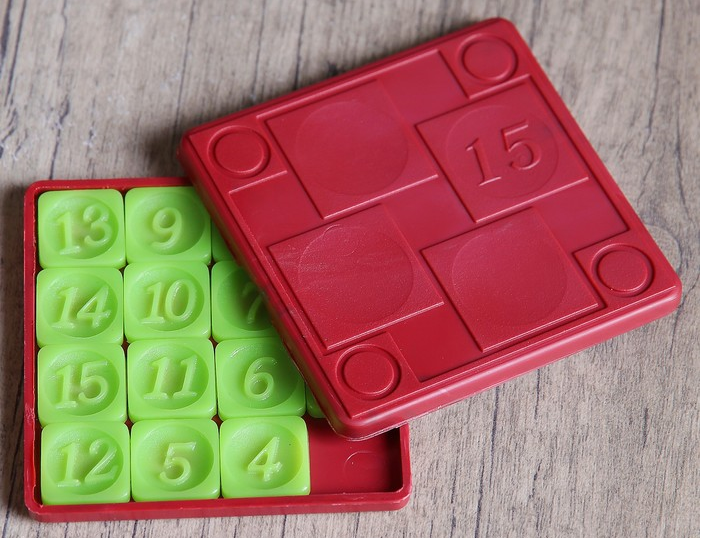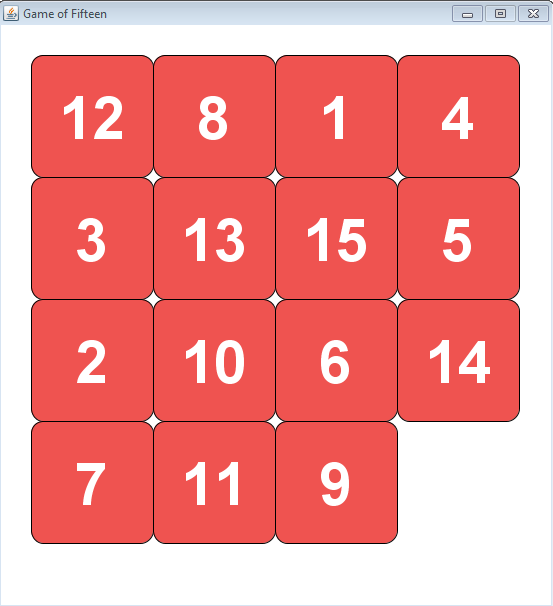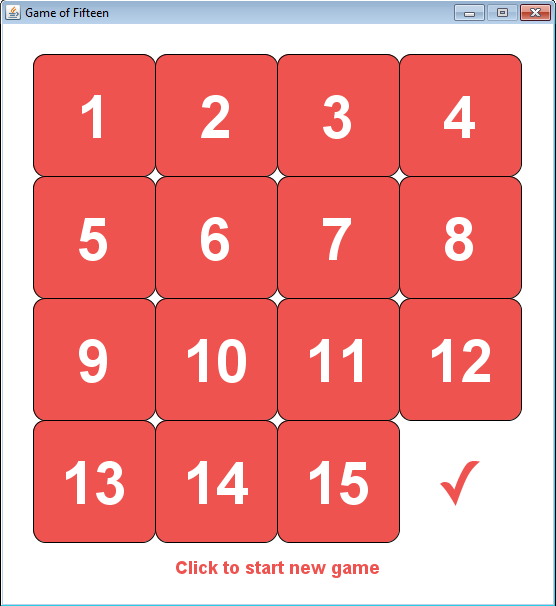"Fifteen" in Java - how to develop a full game

Fifteen, or Fifteen, is a great example of a simple puzzle game popular all over the world. In order to solve the puzzle, you need to arrange the squares with numbers in order, from smaller to larger. It is not easy, but interesting.
In today's tutorial, we show how to develop the Fifteen on Java 8 with Eclipse. To develop the UI, we will use the Swing API.
We remind: for all readers of "Habr" - a discount of 10,000 rubles when writing to any Skillbox course on the promotional code "Habr".
')
Skillbox recommends: Online Profession Java Developer Educational Course.
Game design
At this stage, you need to define the properties:
- Size - the size of the playing field;
- nbTiles - the number of tags in the field. nbTiles = size * size - 1;
- Tiles is a tag, which is a one-dimensional array of integers. Each tag will get a unique value in the range [0, nbTiles]. Zero means an empty square;
- blankPos - the position of the empty square.
Game logic
You need to define a reset method used to initialize a new game position. So we set the value for each element of the array of the tags. Well, then we put the blankPos in the last position of the array.
You also need the shuffle method to shuffle an array of tags. We do not include the empty tag in the process of shuffling to leave it in the same position.
Since only half of the possible starting positions of the puzzle have a solution, you need to check the resulting result of mixing to make sure that the current alignment is generally solved. To do this, we define the isSolvable method.
If a specific tag is preceded by a tag with a higher value, this is considered inversion. When the empty tag is in its place, the number of inversions must be even so that the puzzle is solvable. So, we count the number of inversions and return true if the number is even.
Then it is important to define the isSolved method to check if our Game Of Fifteen alignment is resolved. First we look where the empty tag is. If in the initial position, then the current alignment is new, not previously solved. Then we iterate over the tiles in the reverse order, and if the value of the tag is different from the corresponding index +1, we return false. Otherwise, it’s time to return true at the end of the method, because the puzzle has already been solved.
Another method that needs to be defined is newGame. It is required to create a new instance of the game. To do this, we reset the playing field, then shuffle it and continue until the playing position is resolvable.
Here is an example of the code with key logic of the tags:
private void newGame() { do { reset(); // reset in initial state shuffle(); // shuffle } while(!isSolvable()); // make it until grid be solvable gameOver = false; } private void reset() { for (int i = 0; i < tiles.length; i++) { tiles[i] = (i + 1) % tiles.length; } // we set blank cell at the last blankPos = tiles.length - 1; } private void shuffle() { // don't include the blank tile in the shuffle, leave in the solved position int n = nbTiles; while (n > 1) { int r = RANDOM.nextInt(n--); int tmp = tiles[r]; tiles[r] = tiles[n]; tiles[n] = tmp; } } // Only half permutations of the puzzle are solvable/ // Whenever a tile is preceded by a tile with higher value it counts // as an inversion. In our case, with the blank tile in the solved position, // the number of inversions must be even for the puzzle to be solvable private boolean isSolvable() { int countInversions = 0; for (int i = 0; i < nbTiles; i++) { for (int j = 0; j < i; j++) { if (tiles[j] > tiles[i]) countInversions++; } } return countInversions % 2 == 0; } private boolean isSolved() { if (tiles[tiles.length - 1] != 0) // if blank tile is not in the solved position ==> not solved return false; for (int i = nbTiles - 1; i >= 0; i--) { if (tiles[i] != i + 1) return false; } return true; } Finally, you need to program the movement of the tags in the array. This code will be called later via a callback to respond to the movement of the cursor. Our game will support multiple tile moves at the same time. Thus, after we have converted the pressed position on the screen into a tag, we get the position of the empty tag and look for the direction of movement to support several of its movements simultaneously.
Here is a sample code:
// get position of the click int ex = e.getX() - margin; int ey = e.getY() - margin; // click in the grid ? if (ex < 0 || ex > gridSize || ey < 0 || ey > gridSize) return; // get position in the grid int c1 = ex / tileSize; int r1 = ey / tileSize; // get position of the blank cell int c2 = blankPos % size; int r2 = blankPos / size; // we convert in the 1D coord int clickPos = r1 * size + c1; int dir = 0; // we search direction for multiple tile moves at once if (c1 == c2 && Math.abs(r1 - r2) > 0) dir = (r1 - r2) > 0 ? size : -size; else if (r1 == r2 && Math.abs(c1 - c2) > 0) dir = (c1 - c2) > 0 ? 1 : -1; if (dir != 0) { // we move tiles in the direction do { int newBlankPos = blankPos + dir; tiles[blankPos] = tiles[newBlankPos]; blankPos = newBlankPos; } while(blankPos != clickPos); tiles[blankPos] = 0; We develop UI on Swing API
It's time to do the interface. First we take the class Jpanel. Then we draw tags on the field - to calculate the sizes of each, we will use the data set in the game design parameter:
gridSize = (dim - 2 * margin); tileSize = gridSize / size; Margin is also a parameter specified in the game constructor.
Now you need to define the drawGrid method to draw the grid and the spots on the screen. We analyze the array of the tags and convert the coordinates to the coordinates of the user interface. Then draw each tag with the corresponding number in the center:
private void drawGrid(Graphics2D g) { for (int i = 0; i < tiles.length; i++) { // we convert 1D coords to 2D coords given the size of the 2D Array int r = i / size; int c = i % size; // we convert in coords on the UI int x = margin + c * tileSize; int y = margin + r * tileSize; // check special case for blank tile if(tiles[i] == 0) { if (gameOver) { g.setColor(FOREGROUND_COLOR); drawCenteredString(g, "\u2713", x, y); } continue; } // for other tiles g.setColor(getForeground()); g.fillRoundRect(x, y, tileSize, tileSize, 25, 25); g.setColor(Color.BLACK); g.drawRoundRect(x, y, tileSize, tileSize, 25, 25); g.setColor(Color.WHITE); drawCenteredString(g, String.valueOf(tiles[i]), x , y); } } Finally, override the paintComponent method, which is a derivative of the JPane class. Then we use the drawGrid method, and then the drawStartMessage method to display a message prompting you to click to start the game:
private void drawStartMessage(Graphics2D g) { if (gameOver) { g.setFont(getFont().deriveFont(Font.BOLD, 18)); g.setColor(FOREGROUND_COLOR); String s = "Click to start new game"; g.drawString(s, (getWidth() - g.getFontMetrics().stringWidth(s)) / 2, getHeight() - margin); } } private void drawCenteredString(Graphics2D g, String s, int x, int y) { // center string s for the given tile (x,y) FontMetrics fm = g.getFontMetrics(); int asc = fm.getAscent(); int desc = fm.getDescent(); g.drawString(s, x + (tileSize - fm.stringWidth(s)) / 2, y + (asc + (tileSize - (asc + desc)) / 2)); } @Override protected void paintComponent(Graphics g) { super.paintComponent(g); Graphics2D g2D = (Graphics2D) g; g2D.setRenderingHint(RenderingHints.KEY_ANTIALIASING, RenderingHints.VALUE_ANTIALIAS_ON); drawGrid(g2D); drawStartMessage(g2D); } We respond to user actions in the UI
In order for the game to go on as usual, it is necessary to process user actions in the UI. To do this, add the MouseListener implementation on Jpanel and the code for moving the tags, already shown above:
addMouseListener(new MouseAdapter() { @Override public void mousePressed(MouseEvent e) { // used to let users to interact on the grid by clicking // it's time to implement interaction with users to move tiles to solve the game ! if (gameOver) { newGame(); } else { // get position of the click int ex = e.getX() - margin; int ey = e.getY() - margin; // click in the grid ? if (ex < 0 || ex > gridSize || ey < 0 || ey > gridSize) return; // get position in the grid int c1 = ex / tileSize; int r1 = ey / tileSize; // get position of the blank cell int c2 = blankPos % size; int r2 = blankPos / size; // we convert in the 1D coord int clickPos = r1 * size + c1; int dir = 0; // we search direction for multiple tile moves at once if (c1 == c2 && Math.abs(r1 - r2) > 0) dir = (r1 - r2) > 0 ? size : -size; else if (r1 == r2 && Math.abs(c1 - c2) > 0) dir = (c1 - c2) > 0 ? 1 : -1; if (dir != 0) { // we move tiles in the direction do { int newBlankPos = blankPos + dir; tiles[blankPos] = tiles[newBlankPos]; blankPos = newBlankPos; } while(blankPos != clickPos); tiles[blankPos] = 0; } // we check if game is solved gameOver = isSolved(); } // we repaint panel repaint(); } }); The code is placed in the constructor of the GameOfFifteen class. At the very end, call the newGame method to start a new game.
Full game code
The last step, before seeing the game in action, is to put all the elements of the code together. Here's what happens:
import java.awt.BorderLayout; import java.awt.Color; import java.awt.Dimension; import java.awt.Font; import java.awt.FontMetrics; import java.awt.Graphics; import java.awt.Graphics2D; import java.awt.RenderingHints; import java.awt.event.MouseAdapter; import java.awt.event.MouseEvent; import java.util.Random; import javax.swing.JFrame; import javax.swing.JPanel; import javax.swing.SwingUtilities; // We are going to create a Game of 15 Puzzle with Java 8 and Swing // If you have some questions, feel free to read comments ;) public class GameOfFifteen extends JPanel { // our grid will be drawn in a dedicated Panel // Size of our Game of Fifteen instance private int size; // Number of tiles private int nbTiles; // Grid UI Dimension private int dimension; // Foreground Color private static final Color FOREGROUND_COLOR = new Color(239, 83, 80); // we use arbitrary color // Random object to shuffle tiles private static final Random RANDOM = new Random(); // Storing the tiles in a 1D Array of integers private int[] tiles; // Size of tile on UI private int tileSize; // Position of the blank tile private int blankPos; // Margin for the grid on the frame private int margin; // Grid UI Size private int gridSize; private boolean gameOver; // true if game over, false otherwise public GameOfFifteen(int size, int dim, int mar) { this.size = size; dimension = dim; margin = mar; // init tiles nbTiles = size * size - 1; // -1 because we don't count blank tile tiles = new int[size * size]; // calculate grid size and tile size gridSize = (dim - 2 * margin); tileSize = gridSize / size; setPreferredSize(new Dimension(dimension, dimension + margin)); setBackground(Color.WHITE); setForeground(FOREGROUND_COLOR); setFont(new Font("SansSerif", Font.BOLD, 60)); gameOver = true; addMouseListener(new MouseAdapter() { @Override public void mousePressed(MouseEvent e) { // used to let users to interact on the grid by clicking // it's time to implement interaction with users to move tiles to solve the game ! if (gameOver) { newGame(); } else { // get position of the click int ex = e.getX() - margin; int ey = e.getY() - margin; // click in the grid ? if (ex < 0 || ex > gridSize || ey < 0 || ey > gridSize) return; // get position in the grid int c1 = ex / tileSize; int r1 = ey / tileSize; // get position of the blank cell int c2 = blankPos % size; int r2 = blankPos / size; // we convert in the 1D coord int clickPos = r1 * size + c1; int dir = 0; // we search direction for multiple tile moves at once if (c1 == c2 && Math.abs(r1 - r2) > 0) dir = (r1 - r2) > 0 ? size : -size; else if (r1 == r2 && Math.abs(c1 - c2) > 0) dir = (c1 - c2) > 0 ? 1 : -1; if (dir != 0) { // we move tiles in the direction do { int newBlankPos = blankPos + dir; tiles[blankPos] = tiles[newBlankPos]; blankPos = newBlankPos; } while(blankPos != clickPos); tiles[blankPos] = 0; } // we check if game is solved gameOver = isSolved(); } // we repaint panel repaint(); } }); newGame(); } private void newGame() { do { reset(); // reset in intial state shuffle(); // shuffle } while(!isSolvable()); // make it until grid be solvable gameOver = false; } private void reset() { for (int i = 0; i < tiles.length; i++) { tiles[i] = (i + 1) % tiles.length; } // we set blank cell at the last blankPos = tiles.length - 1; } private void shuffle() { // don't include the blank tile in the shuffle, leave in the solved position int n = nbTiles; while (n > 1) { int r = RANDOM.nextInt(n--); int tmp = tiles[r]; tiles[r] = tiles[n]; tiles[n] = tmp; } } // Only half permutations of the puzzle are solvable. // Whenever a tile is preceded by a tile with higher value it counts // as an inversion. In our case, with the blank tile in the solved position, // the number of inversions must be even for the puzzle to be solvable private boolean isSolvable() { int countInversions = 0; for (int i = 0; i < nbTiles; i++) { for (int j = 0; j < i; j++) { if (tiles[j] > tiles[i]) countInversions++; } } return countInversions % 2 == 0; } private boolean isSolved() { if (tiles[tiles.length - 1] != 0) // if blank tile is not in the solved position ==> not solved return false; for (int i = nbTiles - 1; i >= 0; i--) { if (tiles[i] != i + 1) return false; } return true; } private void drawGrid(Graphics2D g) { for (int i = 0; i < tiles.length; i++) { // we convert 1D coords to 2D coords given the size of the 2D Array int r = i / size; int c = i % size; // we convert in coords on the UI int x = margin + c * tileSize; int y = margin + r * tileSize; // check special case for blank tile if(tiles[i] == 0) { if (gameOver) { g.setColor(FOREGROUND_COLOR); drawCenteredString(g, "\u2713", x, y); } continue; } // for other tiles g.setColor(getForeground()); g.fillRoundRect(x, y, tileSize, tileSize, 25, 25); g.setColor(Color.BLACK); g.drawRoundRect(x, y, tileSize, tileSize, 25, 25); g.setColor(Color.WHITE); drawCenteredString(g, String.valueOf(tiles[i]), x , y); } } private void drawStartMessage(Graphics2D g) { if (gameOver) { g.setFont(getFont().deriveFont(Font.BOLD, 18)); g.setColor(FOREGROUND_COLOR); String s = "Click to start new game"; g.drawString(s, (getWidth() - g.getFontMetrics().stringWidth(s)) / 2, getHeight() - margin); } } private void drawCenteredString(Graphics2D g, String s, int x, int y) { // center string s for the given tile (x,y) FontMetrics fm = g.getFontMetrics(); int asc = fm.getAscent(); int desc = fm.getDescent(); g.drawString(s, x + (tileSize - fm.stringWidth(s)) / 2, y + (asc + (tileSize - (asc + desc)) / 2)); } @Override protected void paintComponent(Graphics g) { super.paintComponent(g); Graphics2D g2D = (Graphics2D) g; g2D.setRenderingHint(RenderingHints.KEY_ANTIALIASING, RenderingHints.VALUE_ANTIALIAS_ON); drawGrid(g2D); drawStartMessage(g2D); } public static void main(String[] args) { SwingUtilities.invokeLater(() -> { JFrame frame = new JFrame(); frame.setDefaultCloseOperation(JFrame.EXIT_ON_CLOSE); frame.setTitle("Game of Fifteen"); frame.setResizable(false); frame.add(new GameOfFifteen(4, 550, 30), BorderLayout.CENTER); frame.pack(); // center on the screen frame.setLocationRelativeTo(null); frame.setVisible(true); }); } } Finally, play!
It's time to start the game and test it in action. The field should look like this:

We try to solve the puzzle. If everything went well, we get this:

That's all. Did you expect more? :)
Skillbox recommends:
- Practical course "Mobile Developer PRO" .
- Applied online course "Python Data Analyst" .
- Two-year practical course "I am a web developer PRO" .
Source: https://habr.com/ru/post/445758/
All Articles